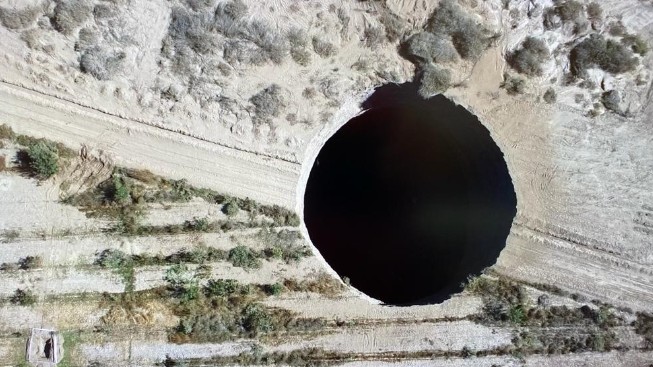Enormous sinkhole wide enough to swallow the White House opens in Chile
The pit is more than 100 feet (30 meters) across and may be six times as deep.

An enormous sinkhole wide enough to swallow the White House has opened up on a plot of mining land in Chile, according to Sernageomin, the country's National Service of Geology and Mining.
The gaping, 104-foot-wide (32 meters) hole appeared Saturday (July 30) in a rural area outside the town of Tierra Amarilla, about 500 miles (800 kilometers) north of the capital city, Santiago. (In comparison, the White House measures about 85 feet, or 26 m, wide.)The hole appears to be about 656 feet (200 m) deep, with a reservoir of water sloshing around the bottom, according to Vice.
The hole opened on the site of the Alcaparrosa copper mine. According to Lundin Mining, the Canadian company that owns the mine, no injuries or damage have been reported. Sernageomin geologists are investigating the hole and have placed a 328-foot (100 m) security perimeter around the site.
Sinkholes are pits that form over areas where water gathers underground without external drainage, causing the water to carve out subterranean caverns, Live Science previously reported. Sinkholes also form regularly near old and active mines, where large amounts of rock and ore have been extracted, several studies have shown. Sinkholes often form gradually over many years but can also open quite suddenly, taking cars, homes and streets down with them.
Cristóbal Zúñiga, the mayor of Tierra Amarilla, told a local radio station that the Alcaparrosa mining operation has already taken a toll on his community. According to Zúñiga , tremors and daily blasting from the mine "have destroyed our houses and our streets, and today, destroyed the ground."
"Today it happened in a space that's an agricultural property, but our greatest fear now is that this could happen in a populated place, on a street, in a school," Zuñiga added.
Originally published on Live Science.
Sign up for the Live Science daily newsletter now
Get the world’s most fascinating discoveries delivered straight to your inbox.

Brandon is the space/physics editor at Live Science. His writing has appeared in The Washington Post, Reader's Digest, CBS.com, the Richard Dawkins Foundation website and other outlets. He holds a bachelor's degree in creative writing from the University of Arizona, with minors in journalism and media arts. He enjoys writing most about space, geoscience and the mysteries of the universe.










